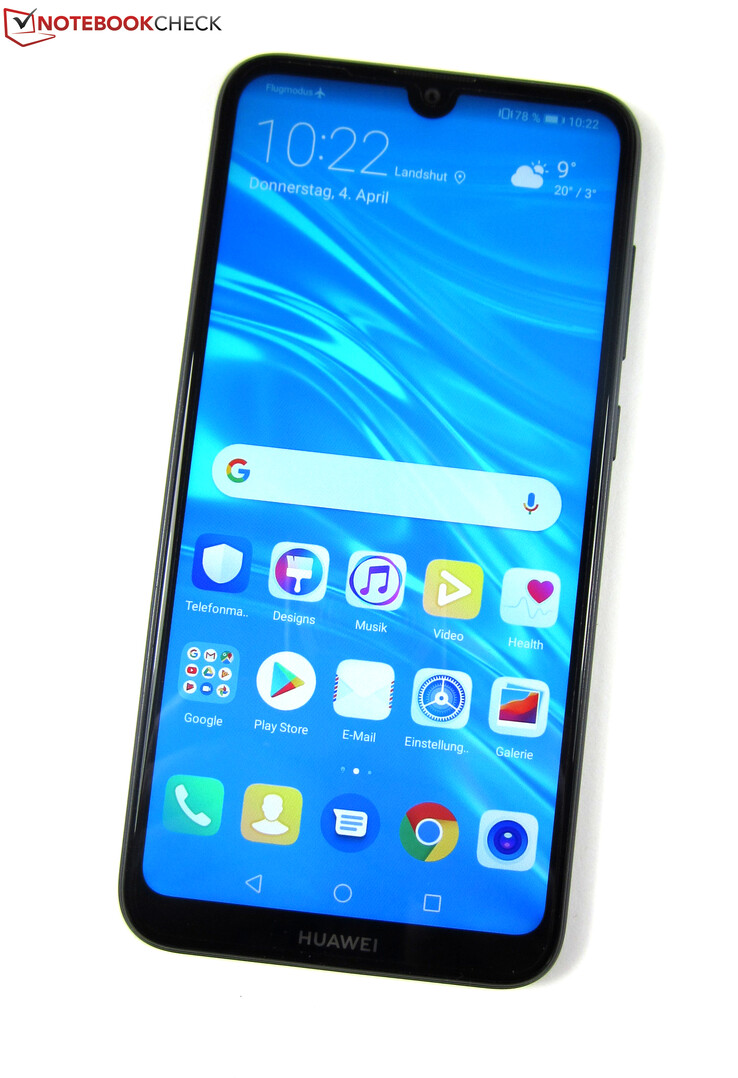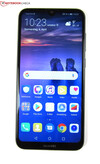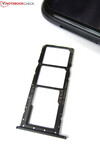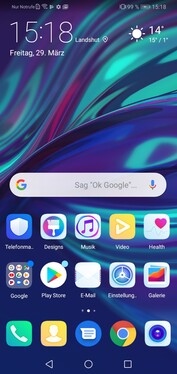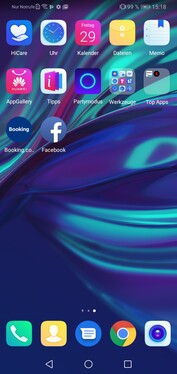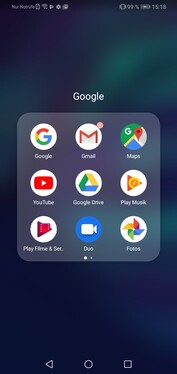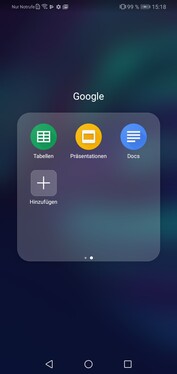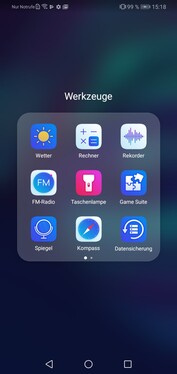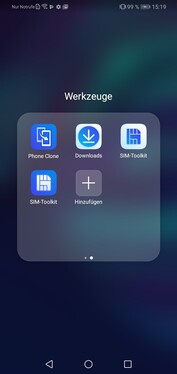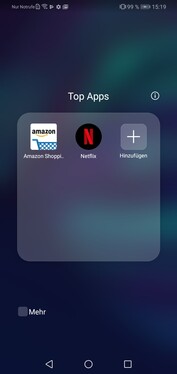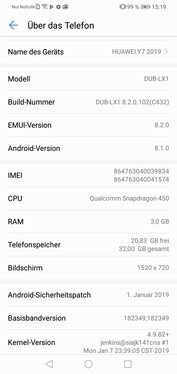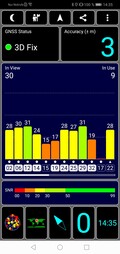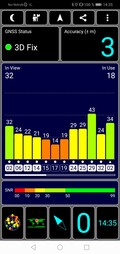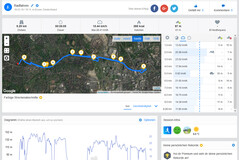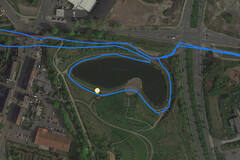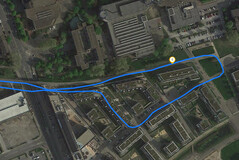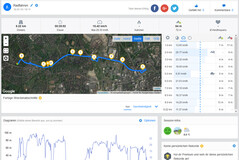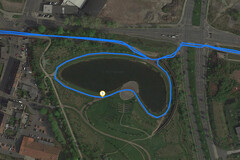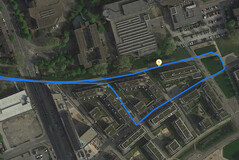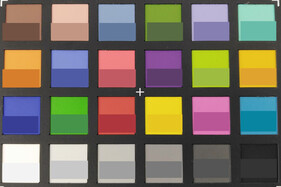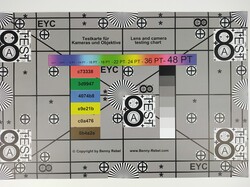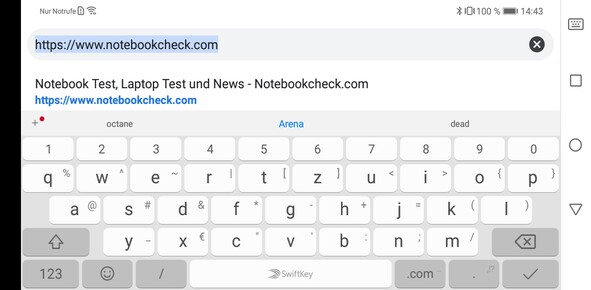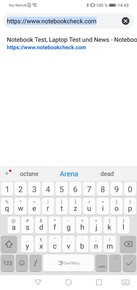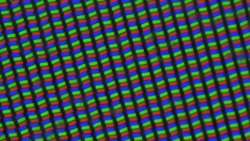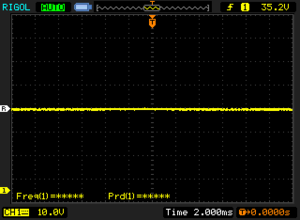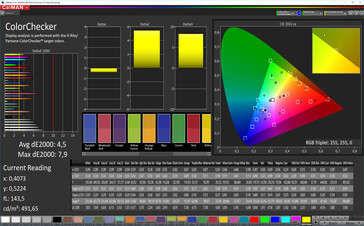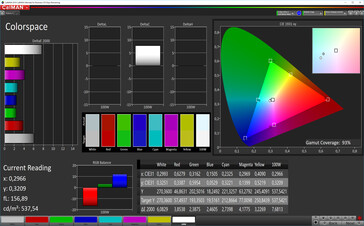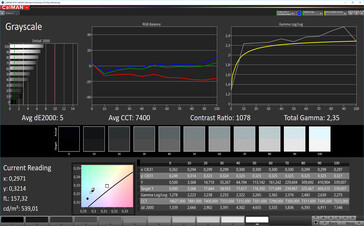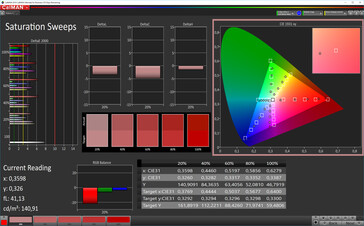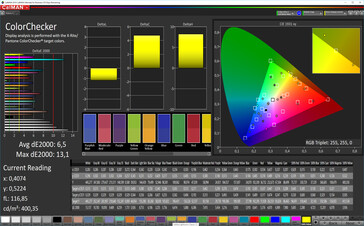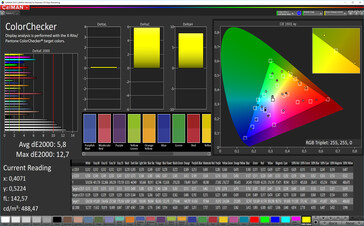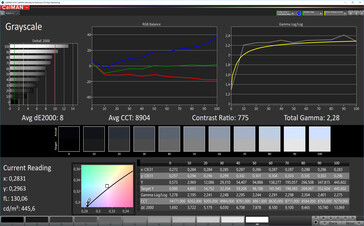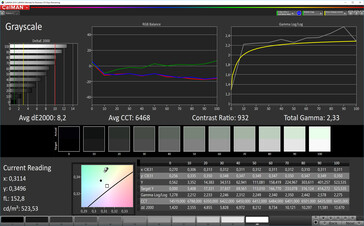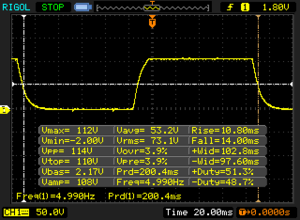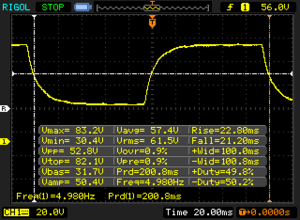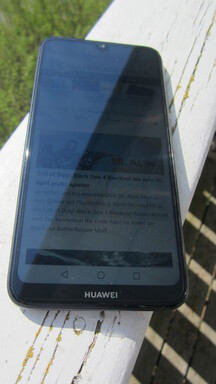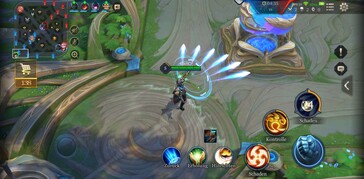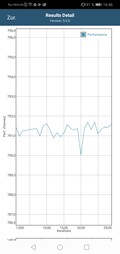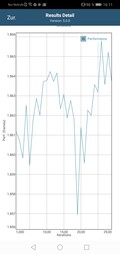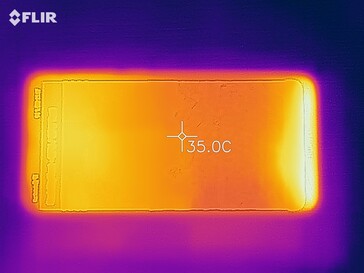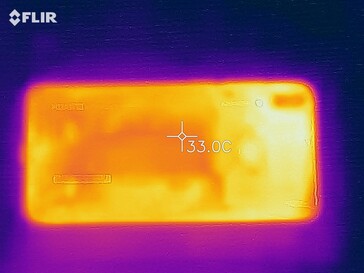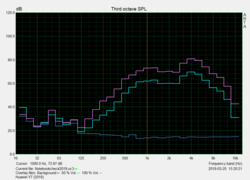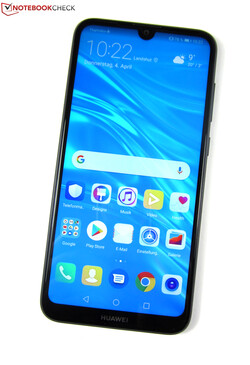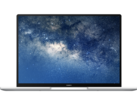Huawei Y7 2019 Smartphone Review
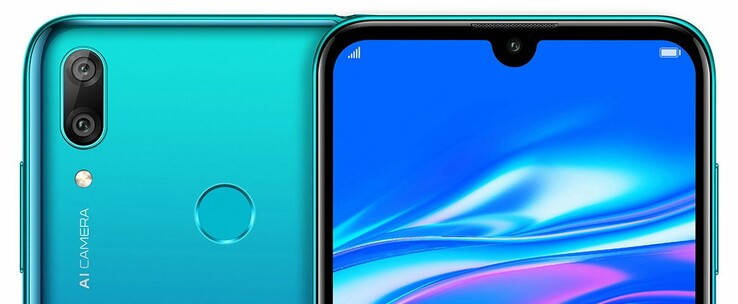
Huawei has upgraded the largest model of its entry-level Y series. The Chinese company aims the Y7 2019 at young buyers and has tried to lure them in by pricing the device at 199 Euros (~US$224). The Y7 2019 has numerous improvements over its predecessor, the Y7 2018, too.
Specifically, the screen has grown from 5.99-inches to 6.26-inches, the storage has doubled from 16 to 32 GB, and there is now 3 GB of RAM compared to the 2 GB with which Huawei equipped the Y7 2018. The SoC has also received a minor upgrade from the Qualcomm Snapdragon 430 to the Snapdragon 450. Furthermore, the new Y7 has dual rear-facing cameras, the main one of which is a 13 MP sensor that is supported by a 2 MP sensor. Moreover, the battery capacity has increased from 3,000 mAh to an impressive 4,000 mAh.
We have chosen to compare the Y7 2019 against other comparably priced and sized budget smartphones. Our comparison devices will include the Huawei P20 Lite, Motorola Moto G7 Play, Nokia 3.1 Plus, Samsung Galaxy A6 Plus (2018) and Xiaomi Mi 8 Lite.
Case
The Y7 2019 is practically the same size as its predecessor, although it has a slightly taller display; the Y7 2019’s display operates natively at 1520x720 compared to the 1440x720 at which the Y7 2018 operates. Huawei has reduced the top and bottom bezels to accommodate the larger display, which gives the Y7 2019 a more elegant look than its predecessor in our view. The company has included a notch too that contains the front-facing camera.
The Y7 2019 has a plastic back case just like its predecessor. However, Huawei has switched to a glossy finish rather than the matte plastic that it used in the Y7 2018. The Y7 2019 still has a restrained design though despite the added glamour and its rounded edges help it fit well in our hands.
Our review unit is solid for an entry-level smartphone and does not creak or bend no matter how hard we try to twist it. We can depress the back cover and the display, but this does not impact its rigidity in our opinion.
Huawei currently sells the Y7 2019 in Midnight Black along with Aurora Blue and Coral Red.
Connectivity
Huawei equips the Y7 2019 with 3 GB RAM and 32 GB of eMMC flash storage. Please keep in mind that EMUI 8.2 takes up around 10 GB of space, so you will only have just under 21 GB free upon delivery.
If that is not enough, then you can use up to 512-GB microSD cards to add additional storage. The Y7 2019 supports exFAT file system so it can read files that are larger than 4 GB, which is a limitation of the FAT file system. However, we could not save apps or data, which is disappointing.
The Y7 2019 also has what many more-expensive smartphones lack. We often complain about OEMs equipping their devices with hybrid second SIM slots, which forces end users to compromise between dual-SIM functionality and microSD card expansion. Thankfully, this is not the case with the Y7 2019, which has two nano-SIM card slots and a dedicated microSD card slot too, so you can use both functionalities simultaneously. Huawei has opted for a micro USB port over a twist-proof USB Type-C port though, which is a shame. One small consolation is that the Y7 2019 supports USB On-The-Go (OTG) for connecting peripherals like a keyboard and mouse, which is useful.
Software
The Y7 2019 ships with Android 8.1 Oreo at the time of writing, atop of which Huawei adds EMUI 8.2. The company has not declared whether it plans to update the device to EMUI 9 and Android 9, but we shall keep you updated if it does. Our review unit had January 1, 2019 security patch updates installed at the time of testing, which were a few months outdated.
EMUI has a slightly different layout than stock Android, which may take some getting used to if you are unfamiliar with it. Huawei also preinstalls a small selection of system tools including an FM radio app, a compass and a mirror. You can uninstall these though, as you can with all the third-party apps that come preloaded too like Amazon Shopping, Booking.com, Facebook, and Netflix. Speaking of streaming services, the Y7 2019 does not have Widevine DRM L1 certification, so it can only stream DRM-protected content in standard definition.
Communication & GPS
The Y7 2019 supports Bluetooth 4.2 and all modern Wi-Fi standards up to IEEE 802.11n. The device also supports LTE bands 1, 3, 5, 7, 8 and 20, which should allow you to connect to most LTE networks. Huawei does not specify what LTE download and upload speeds the Y7 2019 can achieve, but the SoC sets the maximum transfer speeds that the device could theoretically reach. Hence, we can infer from the Snapdragon 450's technical data that the Y7 2019 can achieve up to 300 Mb/s download speeds and 150 Mb/s upload speeds, while it also should operate at LTE Cat. 7.
Disappointingly, the device does not support NFC because it lacks the required chip. Moreover, the Y7 2019 can only connect to 2.4 GHz Wi-Fi networks, which is another area where Huawei has compromised to keep costs down.
Correspondingly, our review unit achieves below average Wi-Fi transfer speeds when connected to our Linksys EA8500 reference router. Although the device maintained a stable connection throughout our tests, it could only place towards the bottom of our comparison tables. The Galaxy A6 Plus (2018), Huawei P20 Lite and Xiaomi Mi 8 Lite have considerably faster Wi-Fi than the Y7 2019 too, as demonstrated by the iperf3 Client comparison tables below.
The Y7 2019 uses BeiDou, GLONASS, GPS and A-GPS for location services. Our review unit can find a satellite fix with up to three metres accuracy within a few seconds, which is impressive for such a cheap smartphone and makes it more accurate than even some flagship devices.
The Y7 2019 also proved its decent GPS accuracy on our bike ride, where we compared its results against the Garmin Edge 500, a professional navigation system. Our review unit could not plot as accurate of a route as the Garmin, but it only deviated by 70 metres over the 9.22 km that the Garmin recorded us having cycled. Hence, the Y7 2019 is accurate enough for all general navigation tasks like cycling, driving or walking.
Telephone Features & Call Quality
The Y7 2019 relies on the default EMUI 8.2 apps for telephony. The phone app immediately displays a numeric keypad upon launch and provides direct access to contacts and favourites. Overall, the Huawei app operates just as well as the stock Google one.
Our review unit also has decent call quality. Both sides of a call always remained intelligible during our tests, although both parties occasionally sounded a bit dampened, for some reason. We experienced no issues when making and receiving calls over speakerphone too.
Cameras
Huawei has equipped the Y7 2019 with an 8 MP front-facing camera that sits in a waterdrop-shaped notch at the top of its display. The sensor has an f/2.0 aperture and can capture images in up to 3264x2448. It can also record video in up to Full HD at 30 FPS too. Photos generally look passable and can be spiced up either with the automatic beautifying function or with AI stickers, the latter of which we have included in our test shots. The Y7 2019 can also trigger the shutter once it recognises a smiling face, as it can if you say "cheese" too. These options, and gesture controls, must first be enabled in the settings of the default camera app.
The dual rear-facing cameras support those modes too along with a Pro mode that has options for adjusting the aperture, white balance and light sensitivity among other settings. Huawei has equipped the Y7 2019 with a 13 MP main sensor that has an f/1.8 aperture, which is supported by a 2 MP depth sensor that the device can use to create bokeh effects. Incidentally, the 2 MP sensor has an f/2.4 aperture.
The Y7 2019 has an amazingly good set of rear cameras for a budget device. Our review unit takes vivid-looking photos in daylight and demarcates between light and dark areas as demonstrated by scenes 1 and 2. Some brighter areas look a touch overexposed for our liking though. Likewise, the sensors struggle to capture fine details like the pattern of the T-shirt on the Notebookcheck mascot. Perhaps expectedly, low-light photography is not a strength of the Y7 2019, as scene 3 shows. In short, our test shot looks blurry and washed-out with weak dynamics.
We also checked our review unit’s main camera under controlled lighting conditions to see how accurately it could reproduce our test chart and ColorChecker Passport reference colours. The results are good, but the Y7 2019 generally overexposes colours; grey tones look accurate though. Our test chart looks sharp too, while the rear-facing cameras have no problems with reproducing black text against colour backgrounds. The bottom corners of the chart look rather pale, but this a problem for many smartphones.
Accessories & Warranty
The Y7 2019 comes with a modular charger (5 V/2 A), a USB Type-A to micro USB cable, a SIM tool and a quick-start guide. Huawei does not currently sell any Y7 2019 specific accessories at the time of writing.
The Y7 2019 comes with 24 months manufacturer’s warranty. Please keep in mind that Huawei limits this to just the device and only affords the battery and the charger six months coverage. This limitation will not affect your statutory rights though. Please see our Guarantees, Return Policies and Warranties FAQ for country-specific information.
Input Devices & Operation
The Y7 2019 has a 10-point multitouch touchscreen, which worked precisely and accurately throughout our tests. Huawei preinstalls SwiftKey as the default keyboard too, which functions just as well as it does on other devices that we have tested. You can replace the keyboard with another, such as those downloadable from the Google Play Store, should you wish to do so.
The Y7 2019 has a variety of security features too, including the classic lock screen password, a fingerprint sensor, and 2D face unlock. All worked reliably during our tests, although the latter is not as secure as the others and cannot be used for high-level authentication like in banking apps.
The fingerprint sensor also recognises up to five fingerprints and has gesture support. These are configurable within settings and include options for accepting calls, stopping an alarm or acting as a camera shutter button. You can swipe down on the sensor to bring down the notification shade too.
We should also point out at this stage that occasionally the USB cable would look like it was connected to our review unit, but the two would not make a connection. On closer inspection we had not seated the cable properly so we would recommend taking care when plugging the Y7 2019 in and to double check that the device is charging.
Display
The Y7 2019 has a 6.26-inch IPS panel that has a 19:9 aspect ratio. The display operates natively at 1520x720 as we mentioned earlier, which Huawei markets as HD+. The display has a 269 PPI pixel density, which is rather poor compared with the 1080p panels of some of our comparison devices.
A higher resolution display would have distinguished the Y7 2019 from many of its competitors, but Huawei has done well in other areas. Our review achieved a chart-topping 542.7 cd/m² average maximum brightness according to X-Rite i1Pro 2, which puts the Y7 2019 well ahead of its predecessor and 3% ahead of our brightest comparison devices. Enabling the ambient light sensor pushes the maximum brightness up 3 cd/m² at the centre of the display. Likewise, the more practical APL50 test, which measures luminosity by evenly distributing light and dark areas across a panel, determines that our review unit reaches an average maximum brightness of 546 cd/m², which is in line with what X-Rite i1Pro 2 recorded too.
The Y7 2019 has a 94% evenly lit display too and has flawless colour reproduction, at least subjectively. The numbers state otherwise though, with our review unit achieving a middling 1,116:1 contrast ratio because of its comparatively high black value, which we measure at 0.49 cd/m².
Positively, the device does not use pulse-width modulation (PWM) to regulate display brightness. We observed no display flickering during our tests, making the Y7 2019 suitable even for those that have sensitive eyes.
| |||||||||||||||||||||||||
Brightness Distribution: 94 %
Center on Battery: 547 cd/m²
Contrast: 1116:1 (Black: 0.49 cd/m²)
ΔE ColorChecker Calman: 4.5 | ∀{0.5-29.43 Ø4.78}
ΔE Greyscale Calman: 5 | ∀{0.09-98 Ø5}
93% sRGB (Calman 2D)
Gamma: 2.35
CCT: 7400 K
| Huawei Y7 2019 IPS, 1520x720, 6.3" | Huawei P20 Lite IPS, 2280x1080, 5.8" | Huawei Y7 2018 IPS, 1440x720, 6" | Motorola Moto G7 Play IPS, 1512x720, 5.7" | Nokia 3.1 Plus IPS, 1440x720, 6" | Samsung Galaxy A6 Plus 2018 Super AMOLED, 2220x1080, 6" | Xiaomi Mi 8 Lite IPS, 2280x1080, 6.3" | |
|---|---|---|---|---|---|---|---|
| Screen | -8% | -3% | -5% | 16% | 29% | 7% | |
| Brightness middle (cd/m²) | 547 | 528 -3% | 393 -28% | 479 -12% | 526 -4% | 519 -5% | 421 -23% |
| Brightness (cd/m²) | 543 | 525 -3% | 365 -33% | 481 -11% | 510 -6% | 513 -6% | 389 -28% |
| Brightness Distribution (%) | 94 | 89 -5% | 85 -10% | 94 0% | 94 0% | 93 -1% | 85 -10% |
| Black Level * (cd/m²) | 0.49 | 0.51 -4% | 0.29 41% | 0.37 24% | 0.17 65% | 0.33 33% | |
| Contrast (:1) | 1116 | 1035 -7% | 1355 21% | 1295 16% | 3094 177% | 1276 14% | |
| Colorchecker dE 2000 * | 4.5 | 4.7 -4% | 5.28 -17% | 4.91 -9% | 6.64 -48% | 1.8 60% | 3.4 24% |
| Colorchecker dE 2000 max. * | 7.9 | 8.9 -13% | 9 -14% | 9.47 -20% | 10.02 -27% | 3.6 54% | 5.9 25% |
| Greyscale dE 2000 * | 5 | 6.4 -28% | 4.2 16% | 6.4 -28% | 6.4 -28% | 1.5 70% | 3.9 22% |
| Gamma | 2.35 94% | 2.22 99% | 2.6 85% | 2.108 104% | 2.344 94% | 2.06 107% | 2.26 97% |
| CCT | 7400 88% | 7987 81% | 7086 92% | 7292 89% | 7989 81% | 6462 101% | 7330 89% |
* ... smaller is better
Screen Flickering / PWM (Pulse-Width Modulation)
| Screen flickering / PWM not detected | |||
In comparison: 53 % of all tested devices do not use PWM to dim the display. If PWM was detected, an average of 8098 (minimum: 5 - maximum: 343500) Hz was measured. | |||
Huawei also includes several display options for you to adjust the colour temperature of the display. The Y7 2019 has a manual mode, which is always nice to see, and three preset modes if you do not want to tweak things that Huawei calls Cold, Standard and Warm.
Our tests with a spectrophotometer and CalMAN show that the Standard mode reproduces colours more accurately of the three presets but at the expense of a visible blue cast. Correspondingly, this mode results in the display having a 7,400 K colour temperature, which is 900 K higher than the ideal value of 6,500 K. The other two presets are fairly colour accurate, but they have their weaknesses too. The Cold setting, for example, amplifies the blue cast while the Warm mode gives the display a slight green tint.
Display Response Times
| ↔ Response Time Black to White | ||
|---|---|---|
| 24.8 ms ... rise ↗ and fall ↘ combined | ↗ 10.8 ms rise | |
| ↘ 14 ms fall | ||
| The screen shows good response rates in our tests, but may be too slow for competitive gamers. In comparison, all tested devices range from 0.1 (minimum) to 240 (maximum) ms. » 57 % of all devices are better. This means that the measured response time is worse than the average of all tested devices (20.2 ms). | ||
| ↔ Response Time 50% Grey to 80% Grey | ||
| 44 ms ... rise ↗ and fall ↘ combined | ↗ 22.8 ms rise | |
| ↘ 21.2 ms fall | ||
| The screen shows slow response rates in our tests and will be unsatisfactory for gamers. In comparison, all tested devices range from 0.165 (minimum) to 636 (maximum) ms. » 73 % of all devices are better. This means that the measured response time is worse than the average of all tested devices (31.6 ms). | ||
The Y7 2019 is also usable outdoors thanks to its high maximum brightness, although we would recommend avoiding direct sunlight where possible. The display will remain readable, but it will look washed-out, while its glossy finish is highly reflective.
Our review unit has stable viewing angles too thanks to its IPS panel. We noticed some minor brightness and colour shifts at acute viewing angles, but this does not fundamentally reduce readability.
Performance
The Y7 2019 has decent system performance thanks to its octa-core Snapdragon 450 SoC and 3 GB of RAM. The OS typically operated smoothly during our tests, although we noticed some lags and stutters during heavy multitasking. However, we were not left waiting for apps to load, so you should have no problems with the Y7 2019 in daily use.
The Snapdragon 450 is currently Qualcomm’s weakest SoC and can operate at up to 1.8 GHz across its eight ARM Cortex-A53 cores. The SoC integrates a Qualcomm Adreno 506 GPU, which Huawei complements with 3 GB of RAM, but the latter cannot prevent the Y7 2019 from languishing in the midfield of our synthetic benchmark comparison tables. Our review unit keeps pace with the Galaxy A6 Plus (2018), and its Snapdragon 450 stable-mate along with the P20 Lite and the Nokia 3.1 Plus. The Y7 2019 generally scored around 20% more than its predecessor too, but it cannot get close to the Mi 8 Lite and the Moto G7 Play with their more powerful SoCs.
The Y7 2019 also finished in the midfield of our browser benchmark comparison tables and consistently scored less than the Mi 8 Lite and the Moto G7 Play. Subjectively, our review unit handles web browsing with ease. The preinstalled Chrome browser operated smoothly throughout our tests and loaded web content quickly.
| JetStream 1.1 - Total Score | |
| Xiaomi Mi 8 Lite (Chrome 71) | |
| Motorola Moto G7 Play | |
| Nokia 3.1 Plus (Chrome 71) | |
| Huawei P20 Lite (Chrome 63) | |
| Average Qualcomm Snapdragon 450 (22 - 22.7, n=13) | |
| Samsung Galaxy A6 Plus 2018 (Chrome 67) | |
| Huawei Y7 2018 (Chrome 66) | |
| Octane V2 - Total Score | |
| Average of class Smartphone (2228 - 121337, n=197, last 2 years) | |
| Xiaomi Mi 8 Lite (Chrome 71) | |
| Motorola Moto G7 Play | |
| Nokia 3.1 Plus (Chrome 71) | |
| Huawei P20 Lite | |
| Huawei Y7 2019 (Chrome 73.0.3683.90) | |
| Samsung Galaxy A6 Plus 2018 (Chrome 67) | |
| Average Qualcomm Snapdragon 450 (3470 - 4115, n=14) | |
| Huawei Y7 2018 (Chrome 66) | |
| Mozilla Kraken 1.1 - Total | |
| Huawei Y7 2018 (Chrome 66) | |
| Average Qualcomm Snapdragon 450 (11012 - 11863, n=14) | |
| Samsung Galaxy A6 Plus 2018 (Chrome 67) | |
| Huawei Y7 2019 (Chrome 73.0.3683.90) | |
| Nokia 3.1 Plus (Chrome 71) | |
| Huawei P20 Lite (Chrome 63) | |
| Motorola Moto G7 Play | |
| Xiaomi Mi 8 Lite (Chrome 71) | |
| Average of class Smartphone (257 - 28190, n=154, last 2 years) | |
| WebXPRT 3 - Overall | |
| Average of class Smartphone (38 - 380, n=31, last 2 years) | |
| Xiaomi Mi 8 Lite (Chrome 71) | |
| Huawei P20 Lite (Chrome 63) | |
| Huawei Y7 2019 (Chrome 73.0.3683.90) | |
| Samsung Galaxy A6 Plus 2018 | |
| Average Qualcomm Snapdragon 450 (28 - 34, n=8) | |
| Huawei Y7 2018 (Chrome 66) | |
| WebXPRT 2015 - Overall | |
| Xiaomi Mi 8 Lite (Chrome 71) | |
| Huawei Y7 2019 (Chrome 73.0.3683.90) | |
| Average Qualcomm Snapdragon 450 (90 - 103, n=7) | |
| Samsung Galaxy A6 Plus 2018 (Chrome 67) | |
| Huawei P20 Lite (Chrome 63) | |
| Huawei Y7 2018 (Chrome 66) | |
* ... smaller is better
The Y7 2019 has 32 GB of eMMC flash storage, which performed well in AndroBench tests. Our review unit has comparatively fast random 4 KB and sequential read speeds, but its write speeds are not noteworthy.
Our review unit also performed better than average in AndroBench microSD tests. The Y7 2019 achieved class-leading transfer speeds with our Toshiba Exceria Pro M501 reference card, albeit marginally so.
| Huawei Y7 2019 | Huawei P20 Lite | Huawei Y7 2018 | Motorola Moto G7 Play | Nokia 3.1 Plus | Samsung Galaxy A6 Plus 2018 | Xiaomi Mi 8 Lite | Average 32 GB eMMC Flash | Average of class Smartphone | |
|---|---|---|---|---|---|---|---|---|---|
| AndroBench 3-5 | 64% | -24% | 54% | -30% | -4% | 15% | -11% | 1177% | |
| Sequential Read 256KB (MB/s) | 305 | 293.9 -4% | 256 -16% | 289 -5% | 272.5 -11% | 298.8 -2% | 282.6 -7% | 242 ? -21% | 2228 ? 630% |
| Sequential Write 256KB (MB/s) | 88.8 | 198.3 123% | 71.5 -19% | 111 25% | 35.72 -60% | 88.5 0% | 172.4 94% | 100.5 ? 13% | 1852 ? 1986% |
| Random Read 4KB (MB/s) | 83.5 | 48.19 -42% | 38.8 -54% | 74 -11% | 52.4 -37% | 72.9 -13% | 81.3 -3% | 43.1 ? -48% | 296 ? 254% |
| Random Write 4KB (MB/s) | 17.48 | 71.1 307% | 9.5 -46% | 73 318% | 8.33 -52% | 16.1 -8% | 18.75 7% | 22.3 ? 28% | 339 ? 1839% |
| Sequential Read 256KB SDCard (MB/s) | 86.4 ? | 83.5 ? -3% | 85 -2% | 84.7 ? -2% | 81.3 ? -6% | 83.4 ? -3% | 85.9 ? -1% | 71.8 ? -17% | |
| Sequential Write 256KB SDCard (MB/s) | 65.8 ? | 69 ? 5% | 61.5 -7% | 64.1 ? -3% | 55.2 ? -16% | 67.8 ? 3% | 64 ? -3% | 52.9 ? -20% |
Games
The Adreno 506 is an entry-level GPU that can handle most games, which you can find on the Google Play Store. Our review unit could not play all games smoothly though as our GameBench frame-rate graphs below demonstrate. The Y7 2019 averaged 31 FPS in Arena of Valor, but it slowly ramped up from 1 FPS, which is rather disconcerting. Likewise, even older titles like Dead Trigger 2 fluctuate between 40 FPS and 60 FPS. Our review unit averaged 56 FPS here, but the gaming experience was not a smooth one.
Moreover, the Y7 2019 could not download complex modern games like Asphalt 9: Legends or PUBG Mobile. The touchscreen and associated sensors worked perfectly throughout our gaming tests though.
Dead Trigger 2
Arena of Valor
Emissions
Temperature
The Y7 2019 is a comparatively hot device. Surface temperatures average 31.8 °C on our review unit and reach a maximum of 38.2 °C under sustained load, which is hotter than many other smartphones that we have tested. The device should never feel more than lukewarm to the touch, although two areas at the bottom of the display reached around 38 °C under load, which will feel rather warm.
We also subjected our review unit to GFXBench battery tests that we ran on a loop for 30 minutes to determine how well it manages its internal temperatures. As the graphs to the right demonstrate, the Y7 2019 had no issues with maintaining optimal frame rates in both the older T-Rex test and the more complex Manhattan test. Hence, the Y7 2019 should not thermal throttle in computationally intensive tasks, despite our experiences in the gaming tests.
(+) The maximum temperature on the upper side is 37.8 °C / 100 F, compared to the average of 35.2 °C / 95 F, ranging from 21.9 to 247 °C for the class Smartphone.
(+) The bottom heats up to a maximum of 34 °C / 93 F, compared to the average of 34 °C / 93 F
(±) In idle usage, the average temperature for the upper side is 33.7 °C / 93 F, compared to the device average of 32.9 °C / 91 F.
Speakers
The Y7 2019 has a single speaker on the underside of its frame that reached 86.7 dB(A) during our tests. Surprisingly, the speaker did not distort despite its comparatively high maximum volume, although it sounds rather thin for our liking. Bass tones are practically non-existent, while mid and high-pitched tones dominate the frequency spectrum. Overall, the mono speaker is good enough for occasionally listening to music or watching videos, but we would recommend using headphones or external speakers for a better listening experience.
Huawei Y7 2019 audio analysis
(+) | speakers can play relatively loud (86.7 dB)
Bass 100 - 315 Hz
(-) | nearly no bass - on average 31.6% lower than median
(±) | linearity of bass is average (10.9% delta to prev. frequency)
Mids 400 - 2000 Hz
(+) | balanced mids - only 4.6% away from median
(+) | mids are linear (6.9% delta to prev. frequency)
Highs 2 - 16 kHz
(±) | higher highs - on average 6.9% higher than median
(±) | linearity of highs is average (7.6% delta to prev. frequency)
Overall 100 - 16.000 Hz
(±) | linearity of overall sound is average (25.5% difference to median)
Compared to same class
» 63% of all tested devices in this class were better, 7% similar, 30% worse
» The best had a delta of 11%, average was 35%, worst was 134%
Compared to all devices tested
» 78% of all tested devices were better, 5% similar, 18% worse
» The best had a delta of 4%, average was 24%, worst was 134%
Huawei Y7 2018 audio analysis
(±) | speaker loudness is average but good (76.8 dB)
Bass 100 - 315 Hz
(-) | nearly no bass - on average 30.7% lower than median
(±) | linearity of bass is average (8.2% delta to prev. frequency)
Mids 400 - 2000 Hz
(±) | higher mids - on average 7.3% higher than median
(±) | linearity of mids is average (7.9% delta to prev. frequency)
Highs 2 - 16 kHz
(±) | higher highs - on average 9% higher than median
(+) | highs are linear (5.9% delta to prev. frequency)
Overall 100 - 16.000 Hz
(-) | overall sound is not linear (33.7% difference to median)
Compared to same class
» 84% of all tested devices in this class were better, 1% similar, 15% worse
» The best had a delta of 11%, average was 35%, worst was 134%
Compared to all devices tested
» 92% of all tested devices were better, 1% similar, 6% worse
» The best had a delta of 4%, average was 24%, worst was 134%
Battery Life
Power Consumption
The Y7 2019 has excellent power consumption. Our review unit consumes a minimum of 0.51 W and averages 1.7 W at idle. Power consumption rises to a maximum of 4.44 W under load but averages 3.17 W. In short, the Y7 2019 has lower power consumption than all but the Galaxy A6 Plus (2018) of our comparison devices. All other devices consume on average between 35% and 47% more than our review unit.
| Off / Standby | |
| Idle | |
| Load |
|
Key:
min: | |
| Huawei Y7 2019 4000 mAh | Huawei P20 Lite 3000 mAh | Huawei Y7 2018 3000 mAh | Motorola Moto G7 Play 3000 mAh | Nokia 3.1 Plus 3500 mAh | Samsung Galaxy A6 Plus 2018 3500 mAh | Xiaomi Mi 8 Lite 3350 mAh | Average Qualcomm Snapdragon 450 | Average of class Smartphone | |
|---|---|---|---|---|---|---|---|---|---|
| Power Consumption | -35% | -38% | -42% | -47% | 28% | -37% | -34% | -63% | |
| Idle Minimum * (Watt) | 0.51 | 0.98 -92% | 0.9 -76% | 1 -96% | 1 -96% | 0.62 -22% | 0.56 -10% | 0.794 ? -56% | 0.842 ? -65% |
| Idle Average * (Watt) | 1.7 | 2 -18% | 1.9 -12% | 1.7 -0% | 2.4 -41% | 0.96 44% | 1.99 -17% | 2.27 ? -34% | 1.439 ? 15% |
| Idle Maximum * (Watt) | 1.85 | 2.11 -14% | 2.3 -24% | 2.6 -41% | 2.9 -57% | 0.99 46% | 2.05 -11% | 2.48 ? -34% | 1.624 ? 12% |
| Load Average * (Watt) | 3.17 | 3.9 -23% | 4.7 -48% | 4.1 -29% | 3.7 -17% | 1.85 42% | 4.62 -46% | 3.95 ? -25% | 7.03 ? -122% |
| Load Maximum * (Watt) | 4.44 | 5.62 -27% | 5.7 -28% | 6.5 -46% | 5.5 -24% | 3.04 32% | 8.94 -101% | 5.38 ? -21% | 11.3 ? -155% |
* ... smaller is better
Battery Life
Huawei has equipped the Y7 2019 with a 4,000 mAh battery. By contrast, all our comparison devices have at least 500-mAh smaller batteries than our review unit, which corresponds with their respective runtimes and helps the Y7 2019 deliver comparatively outstanding battery life.
Our most comparable battery life tests are those where we normalise display brightness to approximately 150 cd/m². We do this for our practical Wi-Fi and looped H.264 video tests, in which the Y7 2019 excelled. Our review unit lasted for 18:33 hours in the former and 15:38 hours in the latter, which are both class-leading runtimes. The Galaxy A6 Plus (2018) is the only smartphone of our comparison devices to get close to those times, although the Nokia 3.1 Plus gets slightly closer in our Wi-Fi test. The Y7 2019 also smashes the Y7 2018 and its comparatively measly 3,000 mAh battery, with it averaging 33% longer runtimes than its predecessor.
Our review unit also charges relatively quickly with its bundled charger and only takes 2:15 hours to reach full charge from 0%. Impressive stuff.
| Huawei Y7 2019 4000 mAh | Huawei P20 Lite 3000 mAh | Huawei Y7 2018 3000 mAh | Motorola Moto G7 Play 3000 mAh | Nokia 3.1 Plus 3500 mAh | Samsung Galaxy A6 Plus 2018 3500 mAh | Xiaomi Mi 8 Lite 3350 mAh | |
|---|---|---|---|---|---|---|---|
| Battery runtime | -46% | -33% | -38% | -18% | -9% | -40% | |
| Reader / Idle (h) | 39.2 | 12.5 -68% | 21.8 -44% | 30.3 -23% | 28 -29% | ||
| H.264 (h) | 15.6 | 7.8 -50% | 11.5 -26% | 15.3 -2% | 11 -29% | ||
| WiFi v1.3 (h) | 18.6 | 9.7 -48% | 10.4 -44% | 11.5 -38% | 15.3 -18% | 14.1 -24% | 9.1 -51% |
| Load (h) | 4.9 | 4.1 -16% | 4.1 -16% | 5.6 14% | 2.5 -49% |
Pros
Cons
Verdict
The Huawei Y7 2019 is a triumphant upgrade over the Y7 2018. The Chinese manufacturer has improved in almost every important area including design, display, performance and battery life. Its narrow bezels and 6.26-inch IPS panel also make the Y7 2019 look more expensive than it is.
The combination of 3 GB of RAM, 32 GB of storage space and a Qualcomm Snapdragon 450 SoC is decent for an entry-level device too. There are devices out there that offer better performance for the same price, but few also have decent cameras, true dual SIM and microSD card functionality along with fantastic battery life.
The Huawei Y7 2019 is excellent value for money. Few entry-level smartphones offer as much as the Y7 2019 does.
Of course, Huawei has compromised on some areas to keep costs down. The 720p resolution is disappointing as is the lack of NFC and the inclusion of a micro USB port rather than Type-C. The Motorola Moto G7 Play and Xiaomi Mi 8 Lite offer better performance, while the Samsung Galaxy A6 Plus (2018) would be a solid alternative too and has NFC. However, Huawei has got a lot right with the Y7 2019, and its shortcomings should not detract from what is a superb entry-level smartphone.
Huawei Y7 2019
- 10/31/2019 v7 (old)
Manuel Masiero




